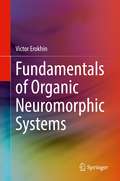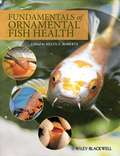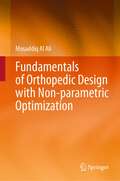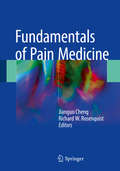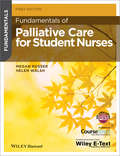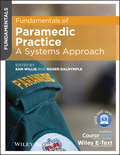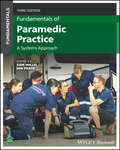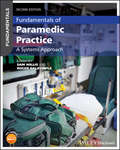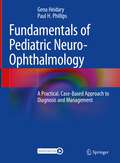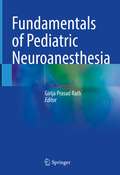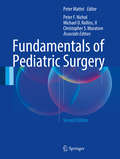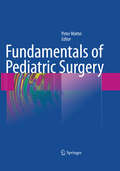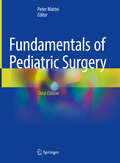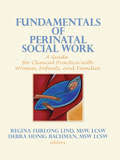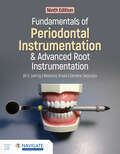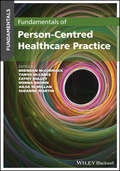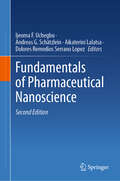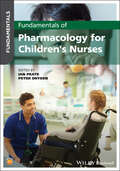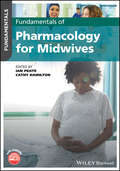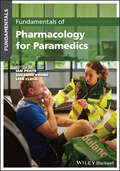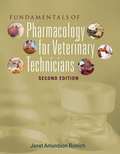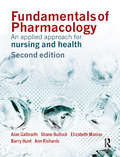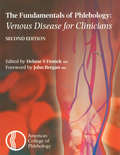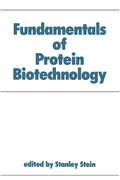- Table View
- List View
Fundamentals of Organic Neuromorphic Systems
by Victor ErokhinThis book describes the essential requirements for the realization of neuromorphic systems, where memristive devices play a key role. A comprehensive description to organic memristive devices, including working principles and models of the function, preparation methods, properties and different applications is presented. A comparative analysis of organic and inorganic systems is given. The author discusses all aspects of current research in organic memristive devices: fabrication techniques, properties, synapse mimicking circuits, and neuromorphic systems (including perceptrons), etc.Describes requirements of electronic circuits and systems to be considered as neuromorphic systems;Provides a single-source reference to the state-of-the-art in memristive devices as key elements of neuromorphic systems;Provides a comparative analysis of advantages and drawbacks between organic and inorganic devices and systems;Includes a systematic overview of organic memristive devices, including fabrication methods, properties, synapse mimicking circuits, and neuromorphic systems;Discusses a variety of unconventional applications, based on bio-inspired circuits and neuromorphic systems.
Fundamentals of Ornamental Fish Health
by Helen E. RobertsFundamentals of Ornamental Fish Health is a complete guide to managing the health and well-being of ornamental aquatic animals. Grounded in the foundations of fish medical care, the book summarizes nonlethal aquatic diagnostics and medicine, putting the information within a clinical context. Providing a comprehensive overview of the subject, Fundamentals of Ornamental Fish Health equips aquatic animal health professionals with all the information needed to competently and effectively treat these patients, from transporting and examining fish to diagnostic techniques and the identification and treatment of specific diseases and syndromes.
Fundamentals of Orthopedic Design with Non-parametric Optimization
by Musaddiq Al AliThis book introduces a fundamental understanding of orthopedic design for both engineers and medical staff. It addresses the gap and mystery that often exists between these two fields and provides a common ground for understanding. The book covers various aspects of orthopedic design, including the anatomy and biomechanics of bones and joints, the materials used in orthopedic devices, and the testing and evaluation of orthopedic devices. It also introduces computer-aided design with additive manufacturing in a practical sense, including the principles of non-parametric optimization (topology and shape optimization) in a scientific and practical way. The author provides dedicated examples and research studies to further clarify the concepts presented in the book and includes some of their own peer-reviewed papers to support the material. Additionally, it covers the practical applications of computer-aided design and additivemanufacturing in orthopedic design, including the use of virtual prototyping, computer simulation, and 3D printing techniques. The book aims to provide a comprehensive guide to orthopedic design and the latest advancements in the field.
Fundamentals of Pain Medicine
by Jianguo Cheng Richard W. RosenquistCharacterized by clarity and straddling the line between scope and depth of information, this concise book provides physicians a comprehensive overview of pain medicine. Chapters are written by some of the leading minds in pain medicine and feature case studies, key points and suggested readings. Multidisciplinary approaches to the clinical and financial challenges of pain with the goal of improving patient quality of life are also discussed. Additionally, the book is in is in tight alignment with the information that trainees are expected to master for the American Board of Anesthesiology’s pain medicine subspecialty certification, as outlined by the Joint Council on Anesthesiology Examinations; it covers the diagnosis of pain states, the management of pain, acute pain, radicular pain, neuropathic pain, chronic visceral pain, headaches, and special populations. This book is a must-have for anyone new to pain medicine or studying for the subspecialty certification.
Fundamentals of Palliative Care for Student Nurses
by Helen Walsh Megan RosserFundamentals of Palliative Care for Student Nurses is a thorough yet accessible introduction and overview of a key area of the nursing programme. This textbook clearly explains the palliation of symptoms and the social context of death and dying. Engaging with the latest guidelines and curriculum, it highlights the practical and communicative skills required for induction programmes and continuing professional development.KEY FEATURES:A full-colour, student-friendly, introduction to the essentials of palliative, or end of life careA topical and timely subject area, explored clearly and conciselyFull of interactive pedagogy and features, including quizzes, multiple choice questions, vignettes/case studies and activitiesFeatures a companion website with links to further reading, additional activities and resources, and self-testing interactive multiple choice questionsFundamentals of Palliative Care for Student Nurses focuses on this area with expert knowledge and compassion, preparing students in order to help them provide the best possible care for their patients and their families.
Fundamentals of Paramedic Practice
by Sam Willis Roger DalrympleAn essential text for the aspiring student paramedic, Fundamentals of Paramedic Practice makes paramedic science and pre-hospital care accessible, straightforward and exciting. It assumes no prior knowledge of the subject, presenting the must-have information that students need about both the theory and practice of what it means to be a paramedic. With extensive full-colour illustrations throughout, as well as activities and scenarios, this user-friendly textbook will support paramedic students throughout their course.
Fundamentals of Paramedic Practice: A Systems Approach (Fundamentals)
by Ian Peate Sam WillisFundamentals of Paramedic Practice An indispensable guide for aspiring paramedics and emergency medical professionals Paramedic practice is swiftly evolving, driven by changes in the paramedic curriculum. To meet the growing demands of the community, student paramedics and clinicians working in out-of-hospital care must stay abreast of this rapid evolution. Fundamentals of Paramedic Practice, Third Edition contributes to driving the profession forward and provides a comprehensive, accessible text authored by experienced paramedics and academics. This third edition has undergone comprehensive updates, introducing new chapters that provide students and recently registered practitioners with a vital overview of the theory and practice of contemporary paramedicine. This is an essential resource for the next generation of paramedics and out-of-hospital practitioners. Readers of the third edition of Fundamentals of Paramedic Practice will find: A multidisciplinary approach incorporating varied and dynamic research New chapters on subjects including end of life care, domestic violence, and paramedic wellbeing Learning activities to aid understanding and retention Fundamentals of Paramedic Practice, Third Edition is ideal for undergraduate paramedic and emergency care students, as well as registered paramedics, clinicians, and educators.
Fundamentals of Paramedic Practice: A Systems Approach (Fundamentals)
by Sam Willis Roger DalrympleDriven by changes to clinical practice, new evidence-based research, and shifts in global economics and politics, the field of paramedic science is rapidly evolving. This new edition of Fundamentals of Paramedic Practice offers students and recently qualified practitioners an accessible and comprehensive introduction to paramedic science and pre-hospital care, providing expert and up-to-date guidance on the essential theories and real-world practice of this dynamic area of emergency medicine.
Fundamentals of Pediatric Neuro-Ophthalmology: A Practical, Case-Based Approach to Diagnosis and Management
by Paul H. Phillips Gena HeidaryFundamentals of Pediatric Neuro-Ophthalmology is the first case-based textbook dedicated to pediatric neuro-ophthalmology. Fundamentals is a must-have resource for ophthalmologists, neurologists, emergency medicine physicians, and pediatricians who are seeking a practical guide for the diagnosis and management of pediatric neuro-ophthalmologic disease. With contributions from experts in the Consortium of Pediatric Neuro-ophthalmologists, the text is an important educational reference for trainees and established physicians alike. Key Features· Fifty-two real-world clinical cases that examine presenting symptoms and signs, differential diagnosis, approach to evaluation, treatment considerations, visual outcomes, and novel insights into disease management· Broad coverage of important topics in pediatric neuro-ophthalmology including Congenital optic nerve anomaliesOptic disc edemaOptic nerve tumorsOptic atrophyStrabismusDisorders of the extraocular musclesNystagmusOther abnormal eye movementsPupillary disordersNeuro-ophthalmologic manifestations in neurologic and systemic diseasesHigher order visual processing disorders · Video library of important clinical signs of neuro-ophthalmologic disease· Discussion of decision making and interpretation of ancillary testing by experts in the field of pediatric neuro-ophthalmology Easy to follow format that will serve as a concise, practical guide with clinical pearls and references for further reading
Fundamentals of Pediatric Neuroanesthesia
by Girija Prasad RathThe book provides an excellent review of all the clinical aspects of neuroanesthesia in children, including neurosurgeries during fetal state to neonatal, infancy, toddler, and school-going age groups. To provide optimal anesthetic care in children undergoing neurosurgery, the care provider must have adequate knowledge on the developing brain and spinal cord, and the effect of anesthetics on the neuronal tissue, and the inherent issues pertaining to neurologic lesions. This book covers the diagnostic, imaging, surgical as well as anesthetic managements of all the neurosurgical problems in children.The chapters include a wide range of topics from basic neurophysiology to general concerns for pediatric neuroanesthesia, including fluid management, blood transfusion, temperature regulation, and surgical positioning, as well as specific issues such as anesthesia for brain tumor surgery, hydrocephalus, neural tube defects, cerebrovascular surgeries such as aneurysmal surgery, arteriovenous malformations (AVMs), Moyamoya disease, and vein of Galen malformation, functional neurosurgery, epilepsy surgery, neuroendoscopy, craniovertebral junction anomalies, spinal surgeries, neurotrauma, and brain abscess with congenital heart diseases. Interesting topics like neuroanesthesia in remote locations, regional anesthesia during neurosurgery, and anesthesia for children with neuromuscular disease are also discussed. Moreover, the book elaborates on advanced neuroanesthesia techniques during fetal neurosurgery and craniopagus separation surgery; and the postoperative intensive care management aspects in each chapter. It is supplemented with figures depicting surgical procedures and positioning, neuroimages, tables and illustrations for easy understanding.This book caters to neuroanesthesiologists, pediatric anesthesiologists, residents, and fellows of anesthesia or neuroanesthesia, practicing anesthesiologists, pediatric neurointensivists, nurse anesthetists, neurosurgeons, and pediatric neurosurgeons. It also serves as a reference book for the DM (neuroanesthesiology and neurocritical care), DNB-SS (neuroanesthesiology), and MD (anesthesiology) curriculums apart from anesthesia residency and pediatric anesthesia/ neurosurgery fellowship programs offered at various Institutions worldwide.
Fundamentals of Pediatric Surgery
by Peter Mattei Ii Peter F. Nichol Michael D. Rollins Christopher S. MuratoreThe previous edition of this book was based on a simple but essential philosophy: provide a practical and up-to-date resource for the practicing surgeon detailing the specific needs and special considerations surrounding the surgical care of children. The second edition of Fundamentals of Pediatric Surgery stays true to the philosophy of the original with several significant enhancements. As well as encompassing the most up-to-date and practical clinical information for the experienced surgeon written in a straightforward narrative style, each chapter provides a rationale for the proposed approach based on the scientific evidence available in the literature and the author's personal clinical experience, supplies a detailed algorithm or clinical protocol in a graphic format, initiates a discussion regarding unanswered questions and proposals for future studies, and includes a list of suggested readings. Chapters cover in great detail a broad range of pediatric general surgery topics, including disorders of all major organ systems of the abdomen and thorax, congenital anomalies presenting in the newborn period, and a variety of maladies germane to the growing field of fetal surgery. The authors also provide authoritative discussions of therapeutic methods and surgical techniques that range from the traditional to the modern, including time-honored open operations, contemporary minimally invasive interventions, and emerging technologies such as single-site and robotic surgery. Written by experts in the field, Fundamentals of Pediatric Surgery, Second Edition is a definitive source of readily available clinical information that residents, fellows or attending surgeons can use to take care of actual patients in real time.
Fundamentals of Pediatric Surgery
by Peter MatteiClinically focused chapters take an evidence-based approach to the management of pediatric surgical patients for residents in training and general surgeons in practice Targets the practitioner who is well-versed in the basic tenets of patient care but who seeks to benefit from the expertise of a seasoned expert A practical guide in the everyday clinical care of pediatric surgical patients for the advanced reader
Fundamentals of Pediatric Surgery
by Peter MatteiThe first two editions of Fundamentals of Pediatric Surgery (2011, 2017) were meant to be comprehensive, state-of-the-art, and practical. The 3rd edition builds on this commitment to such time-honored principles with a text that is even more wide-ranging in its content. It has a deeper commitment to relying on the most current scientific evidence, provides additional study materials to aid in comprehension of concepts and for more effective preparation for oral and written examinations, and be accessible through a variety of multimedia platforms for busy surgeons who have less and less time to sit and read a text but who need to understand this important material while on call, on the go, or between cases. The book maintains its easy-to-read, “this is how I do it” style of writing. Each chapter is written by an eminent expert in the field, supplemented with illustrations and photographs that bring the material to life. Each is also enhanced with editor’s comments, suggested readings and references, case studies, and sample questions. The book is available in a high-quality digital version. To further supplement the learning experience for readers who purchase the text, videos, interviews, and lectures are available on-line. This text will continue to be the most comprehensive, up-to-date, and easily accessible pediatric surgery text of its kind, written in a concise and direct style that covers indications, alternatives, anticipated benefits, and potential pitfalls of every pediatric surgical condition and operation and supported by the latest research published in the current literature.
Fundamentals of Perinatal Social Work: A Guide for Clinical Practice with Women, Infants, and Families
by Regina F Lind Debra H BachmanFundamentals of Perinatal Social Work: A Guide for Clinical Practice provides perinatal social work students and beginning practitioners with an overview of the basics of perinatal social work theory and practice, allowing you to identify and promote a healthy social and emotional environment for pregnant women and/or infants. This book covers the knowledge bases of obstetric and neonatal medicine--and other specialized topics--as applied to social work practice that you’ll need to be familiar with in order to provide effective care for mother and child. As a guide for new workers, students, and experienced social workers in perinatal settings, Fundamentals of Perinatal Social Work is the only book to approach the topic with the necessary overview of medical information. Beyond the history and basics of perinatal and medical social work, you’ll also learn about such related topics as: adoption postpartum depression mental illness diabetesOften, students and new workers find themselves overwhelmed with the medical information and technology they must understand in order to function in perinatal social work. The literature that guides the social work practice is shared with medicine, nursing, public health, and others, and the busy student and new worker do not have the time to gather a body of literature to use as a reference. Fundamentals of Perinatal Social Work provides such a reference and illustrates the depth and breadth the field of perinatal social work has come to encompass today. Perinatal social workers are no longer employed only in hospital settings, but work in AIDS clinics, public health settings, ethics centers, and private practice. Whatever the setting, the goal of perinatal social work is still the same--to maximize the potential of every infant and every family. This book helps you achieve that goal.
Fundamentals of Periodontal Instrumentation and Advanced Root Instrumentation
by Jill S. Gehrig Rebecca Sroda Darlene SaccuzzoNewly revised and updated, Fundamentals of Periodontal Instrumentation and Advanced Root Instrumentation, Ninth Edition is an instructional guide to periodontal instrumentation that takes students from the basic skills—patient positioning, intraoral finger rests, and basic instrumentation—to advanced techniques—assessment of periodontal patients and instrumentation of the root branches of multirooted teeth, root concavities, and furcation areas. The overarching instructional goal of the text is to simplify the teaching and learning process for both educators and students. The Ninth Edition retains the many features that have positioned it as a market-leading text on periodontal instrumentation. It adds new features and a content organization designed to enhance student outcomes.
Fundamentals of Person-Centred Healthcare Practice (Fundamentals)
by Brendan McCormack Dr Tanya McCance Dr Cathy Bulley Dr Donna Brown Ms Ailsa McMillan Professor Suzanne MartinFundamentals of Person-Centred Healthcare Practice presents evidence-based perspectives on a broad range of approaches to person-centred practice in healthcare. Featuring contributions from internationally recognised experts in the field, this valuable textbook helps students and staff across healthcare disciplines understand the essential concepts of person-centred practice in various health-related contexts. Using the Person-centred Practice Framework—an innovative theoretical model based on more than two decades of research and practice—students develop a strong understanding of the different components of person-centredness, their connections and interactions, and how they can be implemented to promote positive healthcare experiences for care providers, service-users, and families. Recognising the dynamic and complex nature of person-centredness, the text emphasises the importance of a common language and a shared understanding of person-centred practice in all areas of healthcare, from hospital and social care systems, to mental health, learning disability, and rehabilitation services. This practical and insightful introduction to the subject: Provides engaging, student-friendly coverage of the central principles and practice of person-centredness within a multi-professional and interdisciplinary context Features cases and examples of person-centred practice in curricula worldwide Includes activities designed to support person-centred practitioner development Discusses the future of person-centred facilitation, learning and practice Offers real-world guidance on providing a holistic approach to developing person-centred relationships that facilitate meaningful connections with others Fundamentals of Person-Centred Healthcare Practice is an indispensable resource for nursing and allied health professionals, and an important reference work for educators, facilitators, supervisors and healthcare practitioners.
Fundamentals of Pharmaceutical Nanoscience
by Ijeoma F. Uchegbu Andreas G. Schätzlein Aikaterini Lalatsa Dolores Remedios Serrano LopezNanoscience or the science of the very small offers the pharmaceutical scientist a wealth of opportunities. By fabricating at the nanoscale, it is possible to exert unprecedented control on drug activity. This textbook will showcase a variety of nanosystems working from their design and construction to their application in the field of drug delivery. The book is intended for graduate students in drug delivery, physical and polymer chemistry, and applied pharmaceutical sciences courses that involve fundamental nanoscience. The purpose of the text is to present physicochemical and biomedical properties of synthetic polymers with an emphasis on their application in polymer therapeutics i.e., pharmaceutical nanosystems, drug delivery and biological performance. There are two main objectives of this text. The first is to provide advanced graduate students with knowledge of the principles of nanosystems and polymer science including synthesis, structure, and characterization of solution and solid state properties. The second is to describe the fundamentals of therapeutic applications of polymers in drug delivery, targeting, response modifiers as well as regulatory issues. The courses, often listed as Advanced Drug Delivery and Applied Pharmaceutics; Polymer Therapeutics; or Nanomedicine, are designed as an overview of the field specifically for graduate students in the Department of Pharmaceutical Sciences Graduate Programs. However, the course content may also be of interest for graduate students in related biomedical research programs. These courses generally include a discussion of the major principles of polymer science and fundamental concepts of application of polymers as modern therapeutics. All courses are moving away from the above mentioned course names and going by ‘pharmaceutical nanoscience or nanosystems’. This area of research and technology development has attracted tremendous attention during the last twodecades and it is expected that it will continue to grow in importance. However, the area is just emerging and courses are limited but they are offered.
Fundamentals of Pharmacology for Children's Nurses (Fundamentals)
by Ian Peate Peter DrydenRegistered Nurses must have thorough knowledge of pharmacology, medicines administration, and the effects of medicines. Fundamentals of Pharmacology for Children's Nurses is written for nurses and allied health professionals involved in the care of children and young people (CYP) to focus exclusively on pharmacology. Filling a gap in current literature on the subject, this much-needed resource develops the competence and confidence required to prescribe, dispense, and administer medicines to children and young people. Emphasising the importance of patient-centered care to CYP, the text describes the role of the healthcare provider working with CYP and their families; explains how to use pharmaceutical and prescribing reference guides; discusses legal and ethical issues; examines pharmacodynamics and pharmacokinetics, and more. Helping readers respond appropriately and compassionately to the needs of those receiving care and their families, this textbook: Covers a wide range of medications used in diabetes, cancer, mental health, and other areas Features a wealth of full-colour images and numerous pedagogical tools including learning objectives, self-test questions, and reflective exercises to enable readers to contextualise and assess their knowledge Presents case studies to reinforce learning, and illustrate the application of theory to practice Provides authoritative and practical guidance on formulations, adverse drug reactions, analgesics, antibiotics, immunisations, and the medications most commonly used when providing care to CYP Includes access to a companion website with interactive MCQs, case studies, references, an image bank, and links to further reading and supplemental resources Fundamentals of Pharmacology for Children's Nurses is essential reading for undergraduate children’s nursing students, trainee nursing associates, those undertaking healthcare programmes of study, as well as those seeking to better understand pharmacology.
Fundamentals of Pharmacology for Midwives (Fundamentals)
by Ian Peate Cathy HamiltonFundamentals of Pharmacology for Midwives provides the reader with a thorough understanding of the essentials of pharmacology associated with childbearing women, and improving safety and care outcomes whilst ensuring the comfort of the mother. It is essential that midwifery students have a knowledge and an understanding of pharmacology, along with an ability to recognise the positive and opposing effects of medicines from conception to birth—including allergies and drug sensitivities, side effects and adverse reactions, contraindications and errors in prescribing, and more. Written with the latest NMC Standards of Proficiency for Registered Midwives (NMC 2019) in mind Each chapter includes ‘test your prior knowledge’ questions, learning outcomes, and skills in practice boxes that encourage the reader to apply the theory to everyday practice Includes companion website for the book at www.wiley.com/go/pharmacologyformidwives that contains multiple-choice questions, powerpoint slides, glossaries, chapter references and other self-test material designed to enhance learning Fundamentals of Pharmacology for Midwives provides a useful reference for those studying to be midwives and support clinicians in the field, helping them become safe and accountable practitioners offering competent and confident women-centred care. All content reviewed by students for students. If you would like to be one of our student reviewers, go to www.reviewnursingbooks.com to find out more. To receive automatic updates on Wiley books and journals, join our email list. Sign up today at www.wiley.com/email
Fundamentals of Pharmacology for Paramedics
by Suzanne Evans Ian Peate Lisa CleggFundamentals of Pharmacology for Paramedics provides students with the insight and understanding of pharmacological essentials needed to respond effectively to the patients' needs. This textbook will help students improve, expand, and enhance their expertise and the overall health and wellbeing of their patients, while boosting their self-confidence as paramedics in the process. This textbook integrates the extensive knowledge of pharmacology into a workable and accessible plan of care that will help to improve patient care. The book also includes: Thorough introductions to pharmacology and how to use pharmaceutical, and prescribing reference guides Comprehensive explorations of the legal and ethical issues of pharmacology within paramedicine and the role of the paramedic in medicines management Practical discussions of pharmacodynamics, pharmacokinetics, drug formulations, and adverse drug reactions In-depth examinations of a wide variety of medicines, including analgesics, antibacterials, and medications used in the cardiovascular, renal, respiratory, gastrointestinal, and nervous systems Written for students of paramedicine, Fundamentals of Pharmacology for Paramedics would also prove an indispensable resource for practicing paramedics seeking a practical, one-stop reference on a challenging subject.
Fundamentals of Pharmacology for Veterinary Technicians (2nd Edition)
by Janet Amundson RomichBuild a strong foundation for understanding how medications may help or potentially harm animals. FUNDAMENTALS OF PHARMACOLOGY FOR VETERINARY TECHNICIANS, 2E, follows a body-systems approach making it easy to correlate basic anatomy and physiology with the drugs used to treat diseases of each body system. A strong foundation of drug administration, pharmacokinetics, measurement systems, as well as drug approval and safety provides the concepts necessary to understand drug actions and safe drug administration. A StudyWARETM CD-ROM accompanies the book which provides additional practice via quizzes or games.
Fundamentals of Pharmacology: An Applied Approach for Nursing and Health
by Ann Richards Alan Galbraith Shane Bullock Elizabeth Manias Barry HuntYour comprehensive and current introduction to the fascinating field of Pharmacology, applied to Nursing and Health! Now fully updated in line with changes in clinical practice, new drugs and research developments.This clear and readable text will guide you through how drugs act within the body coupled with their clinical application. Sections covering social, legal and professional issues are included alongside the scientific principles of pharmacology. Drug groups are considered according to their pharmacological effects, their action on physiological processes and the conditions they are used to treat.
Fundamentals of Pharmacology: For Nursing and Healthcare Students (Fundamentals)
by Ian Peate Barry HillAll registered nurses must have a thorough understanding and a strong knowledge of pharmacology, medicines administration, and the ability to recognise and react to the effects of medicines. Fundamentals of Pharmacology helps nursing and healthcare students develop the skills and confidence required to apply the fundamental principles of pharmacology and to offer safe, competent and compassionate care. Concentrating on the medicines that students are most likely to encounter in real-world practice, this textbook provides concise coverage of pharmacology, essential medicines management principles, legal and ethical issues, drug formulations, analgesics, immunisations, and much more. Clinically focused chapters feature defined learning outcomes, multiple-choice questions, practical examples, and full-colour illustrations to aid readers’ comprehension of the complexities of pharmacology and care provision. The book utilises a straightforward, student-friendly approach to present ‘must-have’ information, with contributions from experienced clinicians and academics. Describes how to use pharmaceutical and prescribing reference guides Stresses the role and importance of compassionate care throughout Contains a full range of pedagogical tools which enhance learning and recall Aligns with current NMC Standards and Proficiencies for Registered Nurses and Nursing Associates Supplemented and supported by a wealth of online extras and resources Fundamentals of Pharmacology is essential reading for all nursing students, trainee nursing associates, post-registration nurses taking ‘nurse prescribing’ or ‘non-medical prescribing’ modules, and newly qualified nurses and nursing associates looking to better understand pharmacology.
Fundamentals of Phlebology: Venous Disease for Clinicians
by Helane S FronekVenous disorders, while generally not life-threatening, affect millions worldwide, causing pain, disability and negatively impacting the lives of sufferers.With contributions from experts in a number of specialties, this highly practical guide provides an understanding of the pathophysiology of venous disease, and details of all the current treatment options available to physicians.
Fundamentals of Protein Biotechnology (Biotechnology And Bioprocessing Ser. #7)
by SteinFills a gap between the existing studies of proteins, which tend to be highly technical and geared toward the practicing protein chemist, and biochemistry textbooks, which focus on general principles. Scientists cover a dozen topics by presenting fundamental principles, an overview, and the practica
